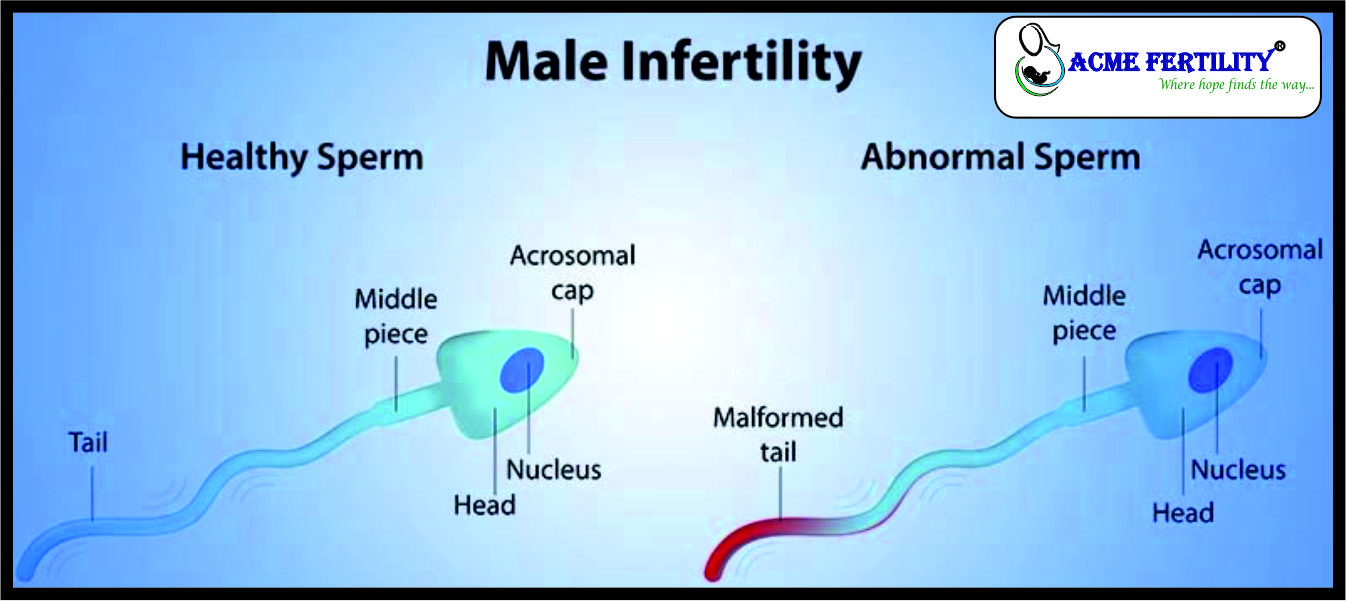Sperm contribute to 50 % of the embryos. This aspect of conception also carries immense importance. Usually, only test done to assess male factor is semen analysis. A proper semen analysis should give idea about different problems.
A) Male factor problems may be related to :
- Inadequate or abnormal sperm production and delivery
- Anatomical problems
- Previous testicular injuries, or
- Hormonal imbalances.
The male partner provides a semen sample that is analyzed with a battery of advanced andrology tests in our fully-equipped Acme Fertility laboratory. In addition to the standard semen analysis using World Health Organization (WHO) criteria, we also analyze sperm to assess the number of motile sperm that can be extracted from the ejaculate
B) Normal semen analysis –
We encourage male partners to have their semen analyzed at Acme Fertility Laboratory so their samples can be tested against rigorous standards. In addition to the routine analysis of our morphology, motility, and concentration, some of the additional testing we perform on the semen includes:
- Routine semen cultures to detect infections
- Pre and post-processing to determine what to expect for our IUI or IVF procedures
- Testing for antisperm antibodies and for iga, igm, and igg antibodies
- Long-term survival studies
- Detection of biochemical markers in the semen, e.g., fructose testing and also additional diagnostic testing for patients with severe male problems e.g. Hos test.
- In cases where the semen analysis is normal, treatment will focus on the work-up of the female partner only. According to who a normal semen analysis includes:
- A sperm concentration of greater than 20 million sperm /ml
- Motility (movement) of greater than 40%, and
- A volume greater than 2cc.
Additionally, our laboratory uses the Kruger classification of more than 14% normal morphology.
C) Abnormal semen analysis
An abnormal sperm analysis is repeated first for verification. Typically, the male partner is evaluated by our andrologist .then according to physical examination and semen parameters fertility management is done.
Azoospermia
Azoospermia is a condition, where there is no sperm in the initial fluid. In most cases, it is caused by either primary testicular failure or hormonal, chromosomal or obstructive abnormalities. Patient need hormonal, urologic, genetic or ultrasonographic examinations to further evaluate the problem.
At ACME Fertility all these evaluations are done under one roof in accordance to the world standards.
DIFFERENT METHODS OF SURGICAL SPERM RETRIEVAL (PESA/MESA/TESA/TESE)
a)Epididymal Aspiration1. This surgical procedure is indicated for cases of congenital absence of the vas deferens (the long tube through which sperm travel during ejaculation), although some males with a vasectomy or failed (vasovasotomy) are also candidates. This technique allows sperm from the epididymis, a tubular structure attached to testicle that serves as a reservoir where sperm mature and are stored. Because very low numbers of sperm are obtained, it is in conjunction with IVF and intracytoplasmic sperm injection.

b)Percutaneous Epididymal Sperm Aspiration (PESA) PESA is indicated for men with irreparable obstruction resulting in Azoospermia (lack of or no sperm), congenital absence of the deferens or who have had vasectomies or failed vasectomy reversals. The procedure takes approximately 10 to 20 minutes unlike epididymal aspiration, and does not require a surgical incision. A small needle is passed directly into the head of the epididymis and fluid is aspirated. Next, the IVF laboratory team retrieves the cells from the fluid and prepares them for ICSI because of the amount secured.
C) Intracytoplasmic Sperm Injection (ICSI) Assisted Microfertilization – Microsurgical fertilization, a form of micromanipulation, can be indicated in case of severe male factor, where conditions such as abnormal sperm movement or low sperm numbers make it impossible for sperms to penetrate and fertilize the egg. One of the methods to assist fertilization is Intracytoplasmic Sperm Injection (ICSI), ICSI involves, the use of very fine instruments to first pick up sperm & then injecting a single sperm directly into the cytoplasm of the egg. The cytoplasm is the area outside the nuclear cell of the oocyte and contains the physical elements of reproduction. ICSI also works for cases of unexplained non-fertilization with conventional IVF.
D) Testicular Tissue Sperm Extraction (TESE) – Surgical removal of a portion of the testes for patients that are good candidates for PESA because of absence of the vas deferens. In the andrology laboratory, tissue is homogenized (minced) & individual sperm is harvested for ICSI.

Definitely believe that which you stated. Your favorite reason appeared to be on the internet the easiest thing to be aware of. I say to you, I certainly get irked while people think about worries that they plainly do not know about. You managed to hit the nail upon the top and defined out the whole thing without having side-effects , people can take a signal. Will likely be back to get more. Thanks
Wow, marvelous weblog structure! How long have you been running a blog for? you make blogging look easy. The overall glance of your site is wonderful, let alone the content material!!